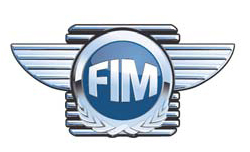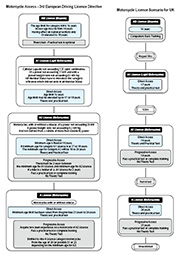There may be Trouble Ahead with the Third European Driving Licence Directive
 Right to Ride has just received a press release from the Fédération Internationale de Motocyclisme (FIM) reporting on what appears to be a major gaffe by the European Commission and Parliament regarding the Third European Driving Licence Directive.
Right to Ride has just received a press release from the Fédération Internationale de Motocyclisme (FIM) reporting on what appears to be a major gaffe by the European Commission and Parliament regarding the Third European Driving Licence Directive.
It seems that the European bodies forgot to discuss the new licence categories with the UNECE to ensure that all the licences could be recognised outside the European Union.
Upon receiving the press release we trawled through the UNECE WP 1 documentation and found that this issue – which specifically focuses on the AM (moped) and A2 (intermediate motorcycle up to 35kW power output) categories – was raised at the Sixty-second session held in Geneva between the 26–29 September 2011.
Specifically, items 17 and 18 under Decision 5: Convention on Road Traffic (1968)
17/18. WP.1 discussed the apparent “driving permit categories and sub-categories” divergences found in the “EU Driver Licence Directive” of December 2006 and the 1968 Convention on Road Traffic. WP.1 agreed that ECE secretariat would send a letter to the EU and its member states to inform about possible non-conformity of the “EU Driver Directive” to Annex 6 of the 1968 Convention.
What this means is that anybody travelling outside the European Union to countries such as Russia, Ukraine, Turkey, the Middle East, Africa and beyond – could find themselves in difficulties as these countries would not recognise these categories and effectively a rider could be stopped and even arrested for not holding an appropriate licence.
As the FIM press release mentions, it could be the case whereby a tourist hires a moped, but only has an AM licence – which would not be valid outside the EU – and could possibly end up being fined or worse!
 As mentioned in the FIM press release, this directive was voted on and passed in the European Parliament in 2006. It was to be transposed into national legislation by 19th January 2011 and enter into force as of 19th January 2013.
As mentioned in the FIM press release, this directive was voted on and passed in the European Parliament in 2006. It was to be transposed into national legislation by 19th January 2011 and enter into force as of 19th January 2013.
We are now in October 2011, member state countries are gearing up to introduce the new categories (including here in Northern Ireland where Right To Ride has just received an invitation to take part in a Stakeholders’ Group for the implementation of this directive).
What now?
Well, it seems that the very slow moving UNECE WP1 will send a letter and we presume will wait for a reply. It will be interesting to see what the outcome of this “Gaffe” will be.
In the meantime…. Let’s face the music and dance (or in this case ride).
FIM press release
New 2013 EU motorcycle licences may not comply with international law – United Nations Geneva office to raise issue with EU Commission in Brussels
11th October 2011
The 3rd European Union Driving Licence Directive (scheduled to come into force in 2013) will create new categories of motorcycle licences.
At a UN meeting attended by FIM in September United Nations traffic law experts highlighted problems with the new EU Directive.
FIM Director of Public Affairs John Chatterton-Ross explains:
“For over 60 years the UN has led the development of international treaty obligations covering free movement of traffic across national borders, and mutual recognition of licences. All member states of the EU are signatories to the Vienna Conventions governing this.
The new EU law poses no problems for riders of motorcycles inside the 27 countries of the EU.
However there could be problems with the validity of the new “A2” licence category for riders travelling outside the EU. This is not a minor problem. The “A2” licence is for intermediate capacity motorcycles up to 35kW power output – motorcycles easily capable of use for long distance travel. The same applies with the new moped category “AM” although these machines are not commonly used for international travel – they are often hired by holidaymakers once they are in a tourist destination.”
He adds:
“FIM has worked with the UN authorities since the 1980s. This matter must be resolved before the new EU law is implemented. This is a complex legislation. Many countries have yet to prepare texts for implementation of the EU Directive into their national law. The deadline for doing so was January of this year! This is yet another difficulty. The UN working party will meet again in March 2012. The Secretariat has undertaken to raise the issue with the EU and all countries which are signatories to the Vienna Conventions. FIM will continue to work towards a solution. Clearly everyone wants to work towards a commonsense solution – but if a rider is involved in an accident we must avoid later legal problems over the validity of the licence they hold.”
About the FIM (www.fim-live.com)
The FIM (Fédération Internationale de Motocyclisme) founded in 1904, is the governing body for motorcycle sport and the global advocate for motorcycling. The FIM is an independent association formed by 103 National Federations throughout the world. It is recognised as the sole competent authority in motorcycle sport by the International Olympic Committee (IOC). Among its 50 FIM World Championships the main events are MotoGP, Superbike, Endurance, Motocross, Supercross, Trial, Enduro, Cross-Country Rallies and Speedway. Furthermore, the FIM is also active and involved in the following areas: public affairs, road safety, touring and protection of the environment. The FIM was the first international sports federation to impose an Environmental Code in 1994.
Information
View Right To Ride’s participation in the consultation on the Driving Licence Directive – Click Here
FEMA’s view from June 2011 regarding – “The transposition of the 3rd Driving Licence Directive reveals big problems with the interpretation of its content by EU member states” – Click Here
More Information
While you may have thought that the legislative process was complicated in your country or in the Europe Union, there is a whole other layer of processes.
The United Nations Economic Commission for Europe (UNECE) was set up in 1947 by the Economic and Social Council (ECOSOC).
ECOSOC was established under the United Nations Charter as the principal organ to coordinate economic, social, and related work of the 14 UN specialized agencies, functional commissions and five regional commissions.
The road safety work in the UNECE started with the establishment, in March 1950, of the “Ad Hoc Working Group on the prevention of road accidents”. The work has been carried out subsequently by the “Group of Experts on Road Traffic Safety (GE.20)” and since 1988 by the Working Party on Road Traffic Safety (WP.1).
Within the general mandate of the United Nations, WP.1 initiates and pursues actions aimed at reinforcing and improving road safety, developing and harmonizing traffic regulations and rules for road signs and signals while also taking account notably of the environment, and strengthening relations between countries. Its primary function is to serve as guardian of the United Nations legal instruments aimed at harmonizing traffic rules.
UNECE also has a Transport Division which has been providing secretariat services to the World Forum for Harmonization of Vehicle Regulations (WP.29) for more than 50 years.
The objective of WP.29 is to initiate and pursue actions aimed at the worldwide harmonization or development of technical regulations for vehicles.
UNECE also carries out other areas of work with a major aim is to promote pan-European economic integration. To do so, it brings together 56 countries located in the European Union, non-EU Western and Eastern Europe, South-East Europe and Commonwealth of Independent States (CIS) and North America.
www.unece.org – www.un.org/en/ecosoc/
NGO Branch – Department of Economic and Social Affairs
Article 71 of the UN Charter opened the door providing for suitable arrangements for consultation with non-governmental organizations.
To be eligible for consultative status, an NGO must have been in existence (officially registered with the appropriate government authorities as an NGO/non-profit) for at least two years, must have an established headquarters, a democratically adopted constitution, authority to speak for its members, a representative structure, appropriate mechanisms of accountability and democraticand transparent decision-making processes.
41 NGOs were granted consultative status by the council in 1946; by 1992 more that 700 NGOs had attained consultative status and the number has been steadily increasing ever since to 3,400 organizations today.
FIM attends meetings as an Non-Governmental Organizations (NGO)
The Federation of European Motorcyclists’ Associations (FEMA) is listed as an NGO with ECOSOC Special Consultative Status and also listed as – not participating in any meetings.


Speak Your Mind